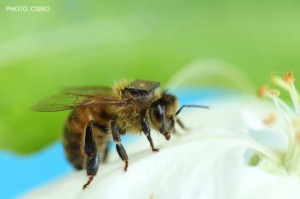RFID Producing A Hive Of Information!
Last week the BBC reported on a new, miniature, longer-range RFID system designed to monitor bee behaviour at Kew Gardens in London. The trial has been created from off-the-shelf components consisting of standard RFID chip and a customised [albeit a slightly cumbersome-looking] aerial, which is supposedly thinner and lighter than other models used to track small insects and which delivers a greater read range. Readers are then dotted around the gardens and connected to credit-card sized, single board, Raspberry Pi computers, which log the readings.
The proof-of-concept is said to enable researchers to detect tagged bees from up to 1.2 meters away. Whilst this might not sound like much, most RFIDs bee trials to date have only been able to detect distances in the low centimetres and typically only once they exited or re-entered their hives. It is hoped this technology trial will open up possibilities for scientists to track bee behaviour over greater distances in the natural landscape and within ecosystems.
However, the largest RFID-tagging of bees is actually being undertaken here in Australia by the CSIRO where scientists have attached up to 5000 sensors to bees in Tasmania in order to learn more about environmental conditions affecting their behaviour. In this current study, bees are carrying a 2.5mm square RFID tag on their backs which has been glued close to their centre of gravity so it does not affect their ability to fly and pollinate. The RFID tags operate at 860 MHz to 960 MHz [UHF] frequency and have an antenna etched into the chip itself. The tagged bees are released into the wild and tracked using RFID readers from a variety of solution providers [N.B. the CSIRO video shows an MTI MINI ME™ reader attached to an android tablet], which are placed around the landscape. Using this system scientists have managed to read more than 10 RFID tags simultaneously at distances up to 30cm.
So why all the buzz about RFID and bees? Well being able to gather real-time insights about insects will significantly expand and deepen our understanding of ecology and biology, resulting in enormous benefits to our society. Bees are the most important insect pollinators of many fruits, vegetables, nuts and flowers, and much of the food we eat today depends solely on bees so their protection is critical. They also provide the key to increasing crop yields which is important for geographical locations where there is a shortage of food supply. Bees are also known to produce a compound called propolis which is thought to have antibacterial, antiviral, antifungal, and anti-inflammatory properties. Propolis has even been suggested to have a role in treating certain cancers as well. Studying bee behaviour could also reveal changes to climate conditions, the presence of dangerous gases, and the arrival of pests like fruit flies which threaten food sources or disease carrying mosquitos.
Stories like this are a good example of how RFID adoption is accelerating across all industry sectors – business, health and medical, science and research, even the home – and for those early adopters, how it is being used to solve problems in new and exciting ways. As the technology shows continuing signs of commodisation, leading organisations will plan to use ‘RFID as infrastructure’ – a platform upon which innovative applications can be rapidly deployed to deliver new insights and solve complex business problems faster than ever before. Relegen has always been a proponent of the fact that real value from RFID will come when we shift our focus from the tags and the hardware to the actionable data asset intelligence delivers. If you’d like to learn more, please reach out to us via +61 (0)2 9998 9000 or sales@relegen.com!
